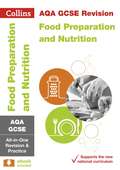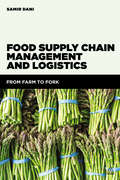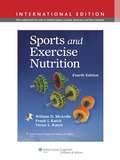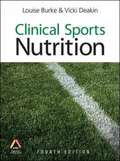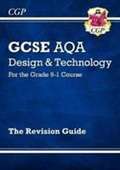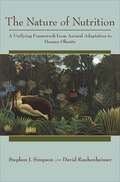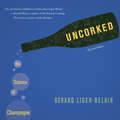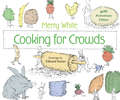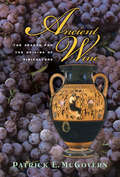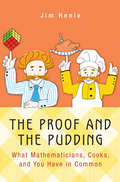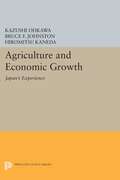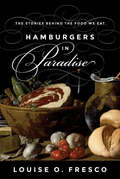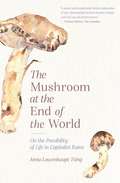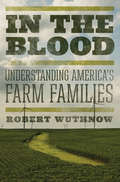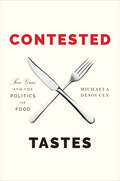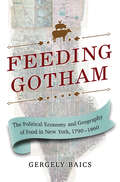- Table View
- List View
Collins GCSE 9-1 Revision: AQA GCSE Food Preparation and Nutrition All-in-One Revision and Practice (PDF)
by Collins Gcse Fiona Balding Kath Callaghan Suzanne Gray Barbara Monks Barbara Rathmill Louise T DaviesExam Board: AQA Level & Subject: GCSE Food preparation and nutrition First teaching: September 2016 First exams: June 2018 This Food preparation and nutrition Revision and Practice book contains clear and accessible explanations of all the GCSE content, with lots of practice opportunities for each topic throughout. Based on new research that proves repeated practice is more effective than repeated study, this book is guaranteed to help you achieve the best results. There are clear and concise revision notes for every topic covered in the curriculum, plus seven practice opportunities to ensure the best results. Includes: * quick tests to check understanding * end-of-topic practice questions * topic review questions later in the book * mixed practice questions at the end of the book * free Q&A flashcards to download online * an ebook version of the revision guide * more topic-by-topic practice and a complete exam-style paper in the added workbook
Food Supply Chain Management and Logistics
by Samir DaniWith the growth of the food industry come unique logistics challenges, new supply routes, demand dynamics and investment re-shaping the future of the food logistics industry. It is therefore important for the food industry to innovate both with regards to demand management and sustainability of food sources for a growing population. Food Supply Chain Management and Logistics is an exciting new text that provides an accessible and essential guide to food supply chain management, considering the food supply chain from 'farm' to 'fork'. Samir Dani shows the reader how to stay ahead of the game by keeping abreast of global best practice, harnessing the very latest technology and squeezing efficiency and profit from increasingly complex supply chains. This book covers essential topics in food supply chain management, including: food supply chain production and manufacturing; food logistics; food regulation, safety and quality; food sourcing; food retailing; risk management; food innovation; technology trends; food sector and economic regeneration; challenges in International food supply chains; triple bottom line trends in the food sector; food security and future challenges.
Food Supply Chain Management And Logistics: From Farm To Fork (PDF)
by Samir DaniWith the growth of the food industry come unique logistics challenges, new supply routes, demand dynamics and investment re-shaping the future of the food logistics industry. It is therefore important for the food industry to innovate both with regards to demand management and sustainability of food sources for a growing population. Food Supply Chain Management and Logistics is an exciting new text that provides an accessible and essential guide to food supply chain management, considering the food supply chain from 'farm' to 'fork'. Samir Dani shows the reader how to stay ahead of the game by keeping abreast of global best practice, harnessing the very latest technology and squeezing efficiency and profit from increasingly complex supply chains. This book covers essential topics in food supply chain management, including: food supply chain production and manufacturing; food logistics; food regulation, safety and quality; food sourcing; food retailing; risk management; food innovation; technology trends; food sector and economic regeneration; challenges in International food supply chains; triple bottom line trends in the food sector; food security and future challenges.
Sports And Exercise Nutrition (PDF)
by William Mcardle Frank Katch Víctor KatchUpdated with the latest cutting-edge research findings, the Fourth Edition helps readers make the bridge between nutrition and exercise concepts and their practical applications. The book provides a strong foundation in the science of exercise nutrition and bioenergetics and offers valuable insights into how the principles work in the real world of physical activity and sports medicine. Case Studies and Personal Health and Exercise Nutrition activities engage readers in practical nutritional assessment problems.
Clinical Sports Nutrition (PDF)
by Louise Burke Vicki Deakin"Clinical Sports Nutrition" is a complete practical and clinical reference that provides state-of-the-art sports nutrition information. Each chapter contains speci c reviews followed by practice tips. Contributions come from leading academics, physicians, and sports dieticians in Australia, Canada, the United States, the United Kingdom, and Finland. "
New Grade 9-1 GCSE Design & Technology AQA Revision Guide (PDF)
by Cgp Books"This CGP Revision Guide is packed with superb study notes for Grade 9-1 AQA GCSE Design & Technology (D&T). Each topic is explained in CGP’s clear, friendly style, supported by diagrams throughout. There are practice questions (with answers) included for each topic, and plenty of top advice on the skills needed for the exams. For even more practice, a matching CGP Exam Practice Workbook (9781782947530) is also available. "
The Nature of Nutrition: A Unifying Framework from Animal Adaptation to Human Obesity
by Stephen J. Simpson David RaubenheimerNutrition has long been considered more the domain of medicine and agriculture than of the biological sciences, yet it touches and shapes all aspects of the natural world. The need for nutrients determines whether wild animals thrive, how populations evolve and decline, and how ecological communities are structured. The Nature of Nutrition is the first book to address nutrition's enormously complex role in biology, both at the level of individual organisms and in their broader ecological interactions. Stephen Simpson and David Raubenheimer provide a comprehensive theoretical approach to the analysis of nutrition--the Geometric Framework. They show how it can help us to understand the links between nutrition and the biology of individual animals, including the physiological mechanisms that determine the nutritional interactions of the animal with its environment, and the consequences of these interactions in terms of health, immune responses, and lifespan. Simpson and Raubenheimer explain how these effects translate into the collective behavior of groups and societies, and in turn influence food webs and the structure of ecosystems. Then they demonstrate how the Geometric Framework can be used to tackle issues in applied nutrition, such as the problem of optimizing diets for livestock and endangered species, and how it can also help to address the epidemic of human obesity and metabolic disease. Drawing on a wealth of examples from slime molds to humans, The Nature of Nutrition has important applications in ecology, evolution, and physiology, and offers promising solutions for human health, conservation, and agriculture.
The Nature of Nutrition: A Unifying Framework from Animal Adaptation to Human Obesity
by Stephen J. Simpson David RaubenheimerNutrition has long been considered more the domain of medicine and agriculture than of the biological sciences, yet it touches and shapes all aspects of the natural world. The need for nutrients determines whether wild animals thrive, how populations evolve and decline, and how ecological communities are structured. The Nature of Nutrition is the first book to address nutrition's enormously complex role in biology, both at the level of individual organisms and in their broader ecological interactions. Stephen Simpson and David Raubenheimer provide a comprehensive theoretical approach to the analysis of nutrition--the Geometric Framework. They show how it can help us to understand the links between nutrition and the biology of individual animals, including the physiological mechanisms that determine the nutritional interactions of the animal with its environment, and the consequences of these interactions in terms of health, immune responses, and lifespan. Simpson and Raubenheimer explain how these effects translate into the collective behavior of groups and societies, and in turn influence food webs and the structure of ecosystems. Then they demonstrate how the Geometric Framework can be used to tackle issues in applied nutrition, such as the problem of optimizing diets for livestock and endangered species, and how it can also help to address the epidemic of human obesity and metabolic disease. Drawing on a wealth of examples from slime molds to humans, The Nature of Nutrition has important applications in ecology, evolution, and physiology, and offers promising solutions for human health, conservation, and agriculture.
Uncorked: The Science of Champagne
by Gérard Liger-Belair Hervé ThisUncorked quenches our curiosity about the inner workings of one of the world's most prized beverages. Esteemed for its freshness, vitality, and sensuality, champagne is a wine of great complexity. Mysteries aplenty gush forth with the popping of that cork. Just what is that fizz? Can you judge champagne quality by how big the bubbles are, how long they last, or how they behave before they fade? And why does serving champagne in a long-stemmed flute prolong its chill and effervescence? Through lively prose and a wealth of state-of-the-art photos, this revised edition of Uncorked unlocks the door to what champagne is all about. Providing an unprecedented close-up view of the beauty in the bubbles, Gérard Liger-Belair presents images that look surprisingly like lovely flowers, geometric patterns, even galaxies as the bubbles rise through the glass and burst forth on the surface. He illustrates how bubbles form not on the glass itself but are "born" out of debris stuck on the glass wall, how they rise, and how they pop. Offering a colorful history of champagne, Liger-Belair tells us how it is made and he asks if global warming could spell champagne's demise. In a brand-new afterword, he updates the reader on new developments in the world of bubble science and delves even more deeply into the processes that give champagne its unique and beautiful character. Bubbly may tickle the nose, but Uncorked tackles what the nose and the naked eye cannot--the spectacular science that gives champagne its charm and champagne drinkers immeasurable pleasure.
Uncorked: The Science of Champagne
by Gérard Liger-Belair Hervé ThisUncorked quenches our curiosity about the inner workings of one of the world's most prized beverages. Esteemed for its freshness, vitality, and sensuality, champagne is a wine of great complexity. Mysteries aplenty gush forth with the popping of that cork. Just what is that fizz? Can you judge champagne quality by how big the bubbles are, how long they last, or how they behave before they fade? And why does serving champagne in a long-stemmed flute prolong its chill and effervescence? Through lively prose and a wealth of state-of-the-art photos, this revised edition of Uncorked unlocks the door to what champagne is all about. Providing an unprecedented close-up view of the beauty in the bubbles, Gérard Liger-Belair presents images that look surprisingly like lovely flowers, geometric patterns, even galaxies as the bubbles rise through the glass and burst forth on the surface. He illustrates how bubbles form not on the glass itself but are "born" out of debris stuck on the glass wall, how they rise, and how they pop. Offering a colorful history of champagne, Liger-Belair tells us how it is made and he asks if global warming could spell champagne's demise. In a brand-new afterword, he updates the reader on new developments in the world of bubble science and delves even more deeply into the processes that give champagne its unique and beautiful character. Bubbly may tickle the nose, but Uncorked tackles what the nose and the naked eye cannot--the spectacular science that gives champagne its charm and champagne drinkers immeasurable pleasure.
Cooking for Crowds: 40th Anniversary Edition
by Merry E. White Edward Koren Darra GoldsteinWhen Cooking for Crowds was first published in 1974, home cooks in America were just waking up to the great foods the rest of the world was eating, from pesto and curries to Ukrainian pork and baklava. Now Merry White's indispensable classic is back in print for a new generation of readers to savor, and her international recipes are as crowd-pleasing as ever--whether you are hosting a large party numbering in the dozens, or a more intimate gathering of family and friends. In this delightful cookbook, White shares all the ingenious tricks she learned as a young Harvard graduate student earning her way through school as a caterer to European scholars, heads of state, and cosmopolitans like Jacqueline Kennedy Onassis. With the help of her friend Julia Child, the cook just down the block in Cambridge, White surmounted unforeseen obstacles and epic-sized crises in the kitchen, along the way developing the surefire strategies described here. All of these recipes can be prepared in your kitchen using ordinary pots, pans, and utensils. For each tantalizing recipe, White gives portions for serving groups of six, twelve, twenty, and fifty. Featuring a lively new introduction by White and Edward Koren's charming illustrations, Cooking for Crowds offers simple, step-by-step instructions for easy cooking and entertaining on a grand scale--from hors d'oeuvres to desserts.
Cooking for Crowds: 40th Anniversary Edition (PDF)
by Merry E. White Edward Koren Darra GoldsteinWhen Cooking for Crowds was first published in 1974, home cooks in America were just waking up to the great foods the rest of the world was eating, from pesto and curries to Ukrainian pork and baklava. Now Merry White's indispensable classic is back in print for a new generation of readers to savor, and her international recipes are as crowd-pleasing as ever--whether you are hosting a large party numbering in the dozens, or a more intimate gathering of family and friends. In this delightful cookbook, White shares all the ingenious tricks she learned as a young Harvard graduate student earning her way through school as a caterer to European scholars, heads of state, and cosmopolitans like Jacqueline Kennedy Onassis. With the help of her friend Julia Child, the cook just down the block in Cambridge, White surmounted unforeseen obstacles and epic-sized crises in the kitchen, along the way developing the surefire strategies described here. All of these recipes can be prepared in your kitchen using ordinary pots, pans, and utensils. For each tantalizing recipe, White gives portions for serving groups of six, twelve, twenty, and fifty. Featuring a lively new introduction by White and Edward Koren's charming illustrations, Cooking for Crowds offers simple, step-by-step instructions for easy cooking and entertaining on a grand scale--from hors d'oeuvres to desserts.
Ancient Wine: The Search for the Origins of Viniculture (PDF)
by Patrick E. Mcgovern Robert G. MondaviThe history of civilization is, in many ways, the history of wine. This book is the first comprehensive and up-to-date account of the earliest stages of vinicultural history and prehistory, which extends back into the Neolithic period and beyond. Elegantly written and richly illustrated, Ancient Wine opens up whole new chapters in the fascinating story of wine and the vine by drawing upon recent archaeological discoveries, molecular and DNA sleuthing, and the texts and art of long-forgotten peoples. Patrick McGovern takes us on a personal odyssey back to the beginnings of this consequential beverage when early hominids probably enjoyed a wild grape wine. We follow the course of human ingenuity in domesticating the Eurasian vine and learning how to make and preserve wine some 7,000 years ago. Early winemakers must have marveled at the seemingly miraculous process of fermentation. From success to success, viniculture stretched out its tentacles and entwined itself with one culture after another (whether Egyptian, Iranian, Israelite, or Greek) and laid the foundation for civilization itself. As medicine, social lubricant, mind-altering substance, and highly valued commodity, wine became the focus of religious cults, pharmacopoeias, cuisines, economies, and society. As an evocative symbol of blood, it was used in temple ceremonies and occupies the heart of the Eucharist. Kings celebrated their victories with wine and made certain that they had plenty for the afterlife. (Among the colorful examples in the book is McGovern's famous chemical reconstruction of the funerary feast--and mixed beverage--of "King Midas.") Some peoples truly became "wine cultures.? When we sip a glass of wine today, we recapitulate this dynamic history in which a single grape species was harnessed to yield an almost infinite range of tastes and bouquets. Ancient Wine is a book that wine lovers and archaeological sleuths alike will raise their glasses to.
The Proof and the Pudding: What Mathematicians, Cooks, and You Have in Common
by Jim HenleTie on your apron and step into Jim Henle's kitchen as he demonstrates how two equally savory pursuits—cooking and mathematics—have more in common than you realize. A tasty dish for gourmets of popular math, The Proof and the Pudding offers a witty and flavorful blend of mathematical treats and gastronomic delights that reveal how life in the mathematical world is tantalizingly similar to life in the kitchen.Take a tricky Sudoku puzzle and a cake that fell. Henle shows you that the best way to deal with cooking disasters is also the best way to solve math problems. Or take an L-shaped billiard table and a sudden desire for Italian potstickers. He explains how preferring geometry over algebra (or algebra over geometry) is just like preferring a California roll to chicken tikka masala. Do you want to know why playfulness is rampant in math and cooking? Or how to turn stinky cheese into an awesome ice cream treat? It’s all here: original math and original recipes plus the mathematical equivalents of vegetarianism, Asian fusion, and celebrity chefs.Pleasurable and lighthearted, The Proof and the Pudding is a feast for the intellect as well as the palate.
The Proof and the Pudding: What Mathematicians, Cooks, and You Have in Common
by Jim HenleTie on your apron and step into Jim Henle's kitchen as he demonstrates how two equally savory pursuits—cooking and mathematics—have more in common than you realize. A tasty dish for gourmets of popular math, The Proof and the Pudding offers a witty and flavorful blend of mathematical treats and gastronomic delights that reveal how life in the mathematical world is tantalizingly similar to life in the kitchen.Take a tricky Sudoku puzzle and a cake that fell. Henle shows you that the best way to deal with cooking disasters is also the best way to solve math problems. Or take an L-shaped billiard table and a sudden desire for Italian potstickers. He explains how preferring geometry over algebra (or algebra over geometry) is just like preferring a California roll to chicken tikka masala. Do you want to know why playfulness is rampant in math and cooking? Or how to turn stinky cheese into an awesome ice cream treat? It’s all here: original math and original recipes plus the mathematical equivalents of vegetarianism, Asian fusion, and celebrity chefs.Pleasurable and lighthearted, The Proof and the Pudding is a feast for the intellect as well as the palate.
Agriculture and Economic Growth: Japan's Experience (PDF)
by Kazushi Ohkawa Bruce F. Johnston Hiromitsu KanedaThis book contains updated versions of a set of papers presented at the International Conference on Agriculture and Economic Development-A Symposium on Japan's Experience which was held in Tokyo, July, 1967. These papers make a comprehensive reappraisal of Japan's agricultural development and its relevance to economic growth over the last 100 years. They emphasize long-term studies in analyzing Japan's agricultural development, with the century following the Meiji Restoration as the historical setting. Intensive consideration is also given to the Meiji Era, 1868-1912.Part I considers the historical phases of Japan's development, and attempts to give a comprehensive exposition of Japan's long-term growth. Part II deals with productivity growth and technological progress; Part III treats agricultural population and labor force; Part IV includes papers dealing with exports of primary products, credit and financial institutions, farm-household savings, the impact of Land Reform, and food consumption patterns.Originally published in 1970.The Princeton Legacy Library uses the latest print-on-demand technology to again make available previously out-of-print books from the distinguished backlist of Princeton University Press. These editions preserve the original texts of these important books while presenting them in durable paperback and hardcover editions. The goal of the Princeton Legacy Library is to vastly increase access to the rich scholarly heritage found in the thousands of books published by Princeton University Press since its founding in 1905.
Hamburgers in Paradise: The Stories behind the Food We Eat
by Louise O. FrescoFor the first time in human history, there is food in abundance throughout the world. More people than ever before are now freed of the struggle for daily survival, yet few of us are aware of how food lands on our plates. Behind every meal you eat, there is a story. Hamburgers in Paradise explains how.In this wise and passionate book, Louise Fresco takes readers on an enticing cultural journey to show how science has enabled us to overcome past scarcities—and why we have every reason to be optimistic about the future. Using hamburgers in the Garden of Eden as a metaphor for the confusion surrounding food today, she looks at everything from the dominance of supermarkets and the decrease of biodiversity to organic foods and GMOs. She casts doubt on many popular claims about sustainability, and takes issue with naïve rejections of globalization and the idealization of "true and honest" food. Fresco explores topics such as agriculture in human history, poverty and development, and surplus and obesity. She provides insightful discussions of basic foods such as bread, fish, and meat, and intertwines them with social topics like slow food and other gastronomy movements, the fear of technology and risk, food and climate change, the agricultural landscape, urban food systems, and food in art.The culmination of decades of research, Hamburgers in Paradise provides valuable insights into how our food is produced, how it is consumed, and how we can use the lessons of the past to design food systems to feed all humankind in the future.
Hamburgers in Paradise: The Stories behind the Food We Eat
by Louise O. FrescoFor the first time in human history, there is food in abundance throughout the world. More people than ever before are now freed of the struggle for daily survival, yet few of us are aware of how food lands on our plates. Behind every meal you eat, there is a story. Hamburgers in Paradise explains how.In this wise and passionate book, Louise Fresco takes readers on an enticing cultural journey to show how science has enabled us to overcome past scarcities—and why we have every reason to be optimistic about the future. Using hamburgers in the Garden of Eden as a metaphor for the confusion surrounding food today, she looks at everything from the dominance of supermarkets and the decrease of biodiversity to organic foods and GMOs. She casts doubt on many popular claims about sustainability, and takes issue with naïve rejections of globalization and the idealization of "true and honest" food. Fresco explores topics such as agriculture in human history, poverty and development, and surplus and obesity. She provides insightful discussions of basic foods such as bread, fish, and meat, and intertwines them with social topics like slow food and other gastronomy movements, the fear of technology and risk, food and climate change, the agricultural landscape, urban food systems, and food in art.The culmination of decades of research, Hamburgers in Paradise provides valuable insights into how our food is produced, how it is consumed, and how we can use the lessons of the past to design food systems to feed all humankind in the future.
The Mushroom at the End of the World: On the Possibility of Life in Capitalist Ruins
by Anna Lowenhaupt TsingMatsutake is the most valuable mushroom in the world—and a weed that grows in human-disturbed forests across the northern hemisphere. Through its ability to nurture trees, matsutake helps forests to grow in daunting places. It is also an edible delicacy in Japan, where it sometimes commands astronomical prices. In all its contradictions, matsutake offers insights into areas far beyond just mushrooms and addresses a crucial question: what manages to live in the ruins we have made? A tale of diversity within our damaged landscapes, The Mushroom at the End of the World follows one of the strangest commodity chains of our times to explore the unexpected corners of capitalism. Here, we witness the varied and peculiar worlds of matsutake commerce: the worlds of Japanese gourmets, capitalist traders, Hmong jungle fighters, industrial forests, Yi Chinese goat herders, Finnish nature guides, and more. These companions also lead us into fungal ecologies and forest histories to better understand the promise of cohabitation in a time of massive human destruction.By investigating one of the world's most sought-after fungi, The Mushroom at the End of the World presents an original examination into the relation between capitalist destruction and collaborative survival within multispecies landscapes, the prerequisite for continuing life on earth.
The Mushroom at the End of the World: On the Possibility of Life in Capitalist Ruins
by Anna Lowenhaupt TsingMatsutake is the most valuable mushroom in the world—and a weed that grows in human-disturbed forests across the northern hemisphere. Through its ability to nurture trees, matsutake helps forests to grow in daunting places. It is also an edible delicacy in Japan, where it sometimes commands astronomical prices. In all its contradictions, matsutake offers insights into areas far beyond just mushrooms and addresses a crucial question: what manages to live in the ruins we have made? A tale of diversity within our damaged landscapes, The Mushroom at the End of the World follows one of the strangest commodity chains of our times to explore the unexpected corners of capitalism. Here, we witness the varied and peculiar worlds of matsutake commerce: the worlds of Japanese gourmets, capitalist traders, Hmong jungle fighters, industrial forests, Yi Chinese goat herders, Finnish nature guides, and more. These companions also lead us into fungal ecologies and forest histories to better understand the promise of cohabitation in a time of massive human destruction.By investigating one of the world's most sought-after fungi, The Mushroom at the End of the World presents an original examination into the relation between capitalist destruction and collaborative survival within multispecies landscapes, the prerequisite for continuing life on earth.
In the Blood: Understanding America’s Farm Families
by Robert WuthnowFarming is essential to the American economy and our daily lives, yet few of us have much contact with farmers except through the food we eat. Who are America's farmers? Why is farming important to them? How are they coping with dramatic changes to their way of life? In the Blood paints a vivid and moving portrait of America’s farm families, shedding new light on their beliefs, values, and complicated relationship with the land.Drawing on more than two hundred in-depth interviews, Robert Wuthnow presents farmers in their own voices as they speak candidly about their family traditions, aspirations for their children, business arrangements, and conflicts with family members. They describe their changing relationships with neighbors, their shifting views about religion, and the subtle ways they defend their personal independence. Wuthnow shares the stories of farmers who operate dairies, raise livestock, and grow our fruit and vegetables. We hear from corn and soybean farmers, wheat-belt farmers, and cotton growers. We gain new insights into how farmers assign meaning to the land, and how they grapple with the increasingly difficult challenges of biotechnology and global markets.In the Blood reveals how, despite profound changes in modern agriculture, farming remains an enduring commitment that runs deeply in the veins of today’s farm families.
In the Blood: Understanding America’s Farm Families
by Robert WuthnowFarming is essential to the American economy and our daily lives, yet few of us have much contact with farmers except through the food we eat. Who are America's farmers? Why is farming important to them? How are they coping with dramatic changes to their way of life? In the Blood paints a vivid and moving portrait of America’s farm families, shedding new light on their beliefs, values, and complicated relationship with the land.Drawing on more than two hundred in-depth interviews, Robert Wuthnow presents farmers in their own voices as they speak candidly about their family traditions, aspirations for their children, business arrangements, and conflicts with family members. They describe their changing relationships with neighbors, their shifting views about religion, and the subtle ways they defend their personal independence. Wuthnow shares the stories of farmers who operate dairies, raise livestock, and grow our fruit and vegetables. We hear from corn and soybean farmers, wheat-belt farmers, and cotton growers. We gain new insights into how farmers assign meaning to the land, and how they grapple with the increasingly difficult challenges of biotechnology and global markets.In the Blood reveals how, despite profound changes in modern agriculture, farming remains an enduring commitment that runs deeply in the veins of today’s farm families.
Contested Tastes: Foie Gras and the Politics of Food
by Michaela DesouceyWho cares about foie gras? As it turns out, many do. In the last decade, this French delicacy—the fattened liver of ducks or geese that have been force-fed through a tube—has been at the center of contentious battles between animal rights activists, artisanal farmers, industry groups, politicians, chefs, and foodies. In Contested Tastes, Michaela DeSoucey takes us to farms, restaurants, protests, and political hearings in both the United States and France to reveal why people care so passionately about foie gras––and why we should care too.Bringing together fieldwork, interviews, and materials from archives and the media on both sides of the Atlantic, DeSoucey offers a compelling look at the moral arguments and provocative actions of pro- and anti-foie gras forces. She combines personal stories with fair-minded analysis of the social contexts within which foie gras is loved and loathed. From the barns of rural southwest France and the headquarters of the European Union in Brussels, to exclusive New York City kitchens and the government offices of Chicago, DeSoucey demonstrates that the debates over foie gras involve heated and controversial politics. Her rich and nuanced account draws our attention to the cultural dynamics of markets, the multivocal nature of "gastropolitics," and the complexities of what it means to identify as a "moral" eater in today's food world.Investigating the causes and consequences of the foie gras wars, Contested Tastes illuminates the social significance of food and taste in the twenty-first century.
Contested Tastes: Foie Gras and the Politics of Food (PDF)
by Michaela DesouceyWho cares about foie gras? As it turns out, many do. In the last decade, this French delicacy—the fattened liver of ducks or geese that have been force-fed through a tube—has been at the center of contentious battles between animal rights activists, artisanal farmers, industry groups, politicians, chefs, and foodies. In Contested Tastes, Michaela DeSoucey takes us to farms, restaurants, protests, and political hearings in both the United States and France to reveal why people care so passionately about foie gras––and why we should care too.Bringing together fieldwork, interviews, and materials from archives and the media on both sides of the Atlantic, DeSoucey offers a compelling look at the moral arguments and provocative actions of pro- and anti-foie gras forces. She combines personal stories with fair-minded analysis of the social contexts within which foie gras is loved and loathed. From the barns of rural southwest France and the headquarters of the European Union in Brussels, to exclusive New York City kitchens and the government offices of Chicago, DeSoucey demonstrates that the debates over foie gras involve heated and controversial politics. Her rich and nuanced account draws our attention to the cultural dynamics of markets, the multivocal nature of "gastropolitics," and the complexities of what it means to identify as a "moral" eater in today's food world.Investigating the causes and consequences of the foie gras wars, Contested Tastes illuminates the social significance of food and taste in the twenty-first century.
Feeding Gotham: The Political Economy and Geography of Food in New York, 1790–1860
by Gergely BaicsNew York City witnessed unparalleled growth in the first half of the nineteenth century, its population rising from thirty thousand people to nearly a million in a matter of decades. Feeding Gotham looks at how America's first metropolis grappled with the challenge of provisioning its inhabitants. It tells the story of how access to food, once a public good, became a private matter left to free and unregulated markets—and of the profound consequences this had for American living standards and urban development.Taking readers from the early republic to the Civil War, Gergely Baics explores the changing dynamics of urban governance, market forces, and the built environment that defined New Yorkers’ experiences of supplying their households. He paints a vibrant portrait of the public debates that propelled New York from a tightly regulated public market to a free-market system of provisioning, and shows how deregulation had its social costs and benefits. Baics uses cutting-edge GIS mapping techniques to reconstruct New York’s changing food landscapes over half a century, following residents into neighborhood public markets, meat shops, and groceries across the city’s expanding territory. He lays bare how unequal access to adequate and healthy food supplies led to an increasingly differentiated urban environment.A masterful blend of economic, social, and geographic history, Feeding Gotham traces how this highly fragmented geography of food access became a defining and enduring feature of the American city.
